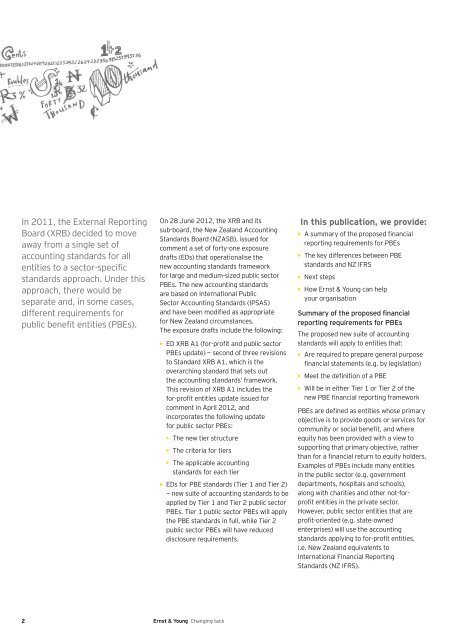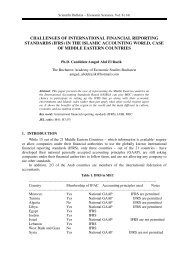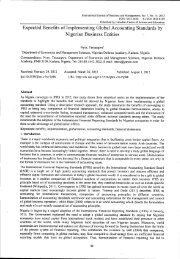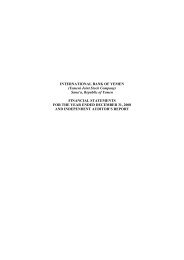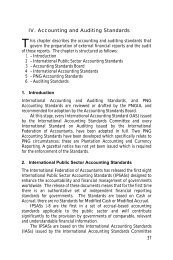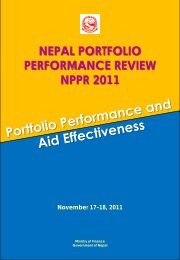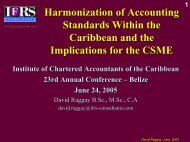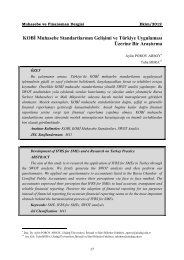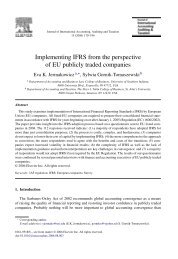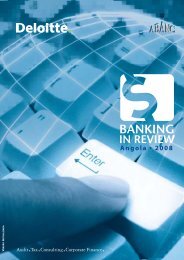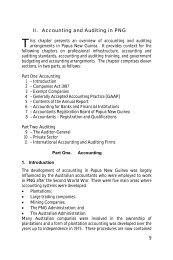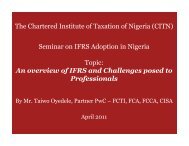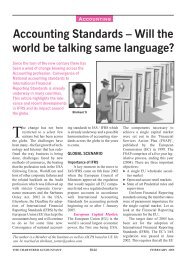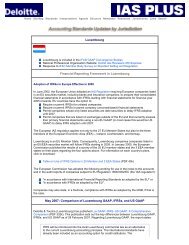Changing tack - A new set of accounting standards ... - Ernst & Young
Changing tack - A new set of accounting standards ... - Ernst & Young
Changing tack - A new set of accounting standards ... - Ernst & Young
You also want an ePaper? Increase the reach of your titles
YUMPU automatically turns print PDFs into web optimized ePapers that Google loves.
In 2011, the External ReportingBoard (XRB) decided to moveaway from a single <strong>set</strong> <strong>of</strong><strong>accounting</strong> <strong>standards</strong> for allentities to a sector-specific<strong>standards</strong> approach. Under thisapproach, there would beseparate and, in some cases,different requirements forpublic benefit entities (PBEs).On 28 June 2012, the XRB and itssub-board, the New Zealand AccountingStandards Board (NZASB), issued forcomment a <strong>set</strong> <strong>of</strong> forty-one exposuredrafts (EDs) that operationalise the<strong>new</strong> <strong>accounting</strong> <strong>standards</strong> frameworkfor large and medium-sized public sectorPBEs. The <strong>new</strong> <strong>accounting</strong> <strong>standards</strong>are based on International PublicSector Accounting Standards (IPSAS)and have been modified as appropriatefor New Zealand circumstances.The exposure drafts include the following:• ED XRB A1 (for-pr<strong>of</strong>it and public sectorPBEs update) — second <strong>of</strong> three revisionsto Standard XRB A1, which is theoverarching standard that <strong>set</strong>s outthe <strong>accounting</strong> <strong>standards</strong>’ framework.This revision <strong>of</strong> XRB A1 includes thefor-pr<strong>of</strong>it entities update issued forcomment in April 2012, andincorporates the following updatefor public sector PBEs:• The <strong>new</strong> tier structure• The criteria for tiers• The applicable <strong>accounting</strong><strong>standards</strong> for each tier• EDs for PBE <strong>standards</strong> (Tier 1 and Tier 2)— <strong>new</strong> suite <strong>of</strong> <strong>accounting</strong> <strong>standards</strong> to beapplied by Tier 1 and Tier 2 public sectorPBEs. Tier 1 public sector PBEs will applythe PBE <strong>standards</strong> in full, while Tier 2public sector PBEs will have reduceddisclosure requirements.In this publication, we provide:• A summary <strong>of</strong> the proposed financialreporting requirements for PBEs• The key differences between PBE<strong>standards</strong> and NZ IFRS• Next steps• How <strong>Ernst</strong> & <strong>Young</strong> can helpyour organisationSummary <strong>of</strong> the proposed financialreporting requirements for PBEsThe proposed <strong>new</strong> suite <strong>of</strong> <strong>accounting</strong><strong>standards</strong> will apply to entities that:• Are required to prepare general purposefinancial statements (e.g. by legislation)• Meet the definition <strong>of</strong> a PBE• Will be in either Tier 1 or Tier 2 <strong>of</strong> the<strong>new</strong> PBE financial reporting frameworkPBEs are defined as entities whose primaryobjective is to provide goods or services forcommunity or social benefit, and whereequity has been provided with a view tosupporting that primary objective, ratherthan for a financial return to equity holders.Examples <strong>of</strong> PBEs include many entitiesin the public sector (e.g. governmentdepartments, hospitals and schools),along with charities and other not-forpr<strong>of</strong>itentities in the private sector.However, public sector entities that arepr<strong>of</strong>it-oriented (e.g. state-ownedenterprises) will use the <strong>accounting</strong><strong>standards</strong> applying to for-pr<strong>of</strong>it entities,i.e. New Zealand equivalents toInternational Financial ReportingStandards (NZ IFRS).The proposed PBE <strong>standards</strong> in the currentEDs have been developed primarily withpublic sector entities in mind. Another EDcontaining revisions to the PBE <strong>standards</strong>to make them more applicable to registeredcharities and other not-for-pr<strong>of</strong>it entitieswill be issued next year (estimated timing isSeptember 2013). However, we are notexpecting that the subsequent revision <strong>of</strong>the PBE <strong>standards</strong> for not-for-pr<strong>of</strong>it entitieswill result in significant changes to the<strong>standards</strong> – it’s more likely that anychanges will be in the nature <strong>of</strong> additionalexamples and application guidance fornot-for-pr<strong>of</strong>it entities, rather than majorchanges to the key principles orrequirements <strong>of</strong> the <strong>standards</strong>.The diagram below outlines the proposedfinancial reporting framework for PBEs:Tier 1 — largeExpenses > $30m plus‘publicly accountable’entities (e.g. issuers)• PBE <strong>standards</strong>Tier 2 — mediumExpenses between$2m - $30mThe <strong>new</strong> PBE <strong>standards</strong> for Tier 1 andTier 2 public sector PBEs are expectedto be issued by the end <strong>of</strong> June 2013.These <strong>standards</strong> are expected to beeffective for financial years beginningon or after 1 July 2014 for public sectorPBEs (i.e. the 2014/15 financial year).The <strong>standards</strong>, once revised for not-forpr<strong>of</strong>itentities, are expected to be effectivefrom 1 April 2015 (i.e. the 2015/16financial year) for Tier 1 and Tier 2registered charities and other privatesector not-for-pr<strong>of</strong>it entities.Key differences betweenPBE <strong>standards</strong> and NZ IFRSThe exact impact <strong>of</strong> public sector PBEsmoving from existing <strong>standards</strong> to PBE<strong>standards</strong> will differ from entity to entity.The impact will also depend on theexisting <strong>standards</strong> applied by the entity(e.g. NZ IFRS in full or with differentialreporting concessions).Public sector PBEs and private sector not-for-pr<strong>of</strong>its (NFPs)• PBE <strong>standards</strong> withreduced disclosuresTier 3 — smallExpenses < $2m andnot in Tier 4• Simple formatreporting• Accrual <strong>accounting</strong>Tier 4 — microExpenses < $40k andpermitted by legislationto be in Tier 4• Simple formatreporting• Cash <strong>accounting</strong>For public sector entities and other PBEscurrently reporting under NZ IFRS, themove from NZ IFRS to the <strong>new</strong> PBE<strong>standards</strong> is the most significant changein <strong>accounting</strong> <strong>standards</strong> since the initialmove to NZ IFRS. However, most PBEsshould find that there is no need to makemany major changes to their <strong>accounting</strong>policies - because the <strong>new</strong> PBE <strong>standards</strong>are based on IPSAS, which are themselvesbased on IFRS.Nevertheless, there are some potentiallysignificant differences and also a range<strong>of</strong> smaller differences between theproposed PBE <strong>standards</strong> and NZ IFRS.Therefore, every PBE will need to gothrough a process <strong>of</strong> identifying relevantdifferences and assessing the impact ontheir financial reporting. That assessmentwill then help to determine what changesmight be needed to <strong>accounting</strong> processesand information systems.2 <strong>Ernst</strong> & <strong>Young</strong> <strong>Changing</strong> <strong>tack</strong> <strong>Ernst</strong> & <strong>Young</strong> <strong>Changing</strong> <strong>tack</strong>3


